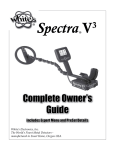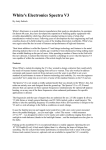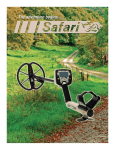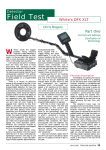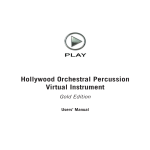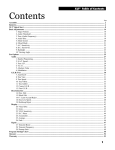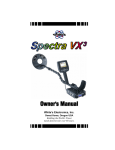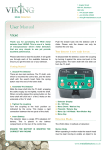Download Spectra V3i™ Field Report Lost Treasure Field Test White`s
Transcript
Spectra V3i™ Field Report Lost Treasure Field Test White’s Electronics Spectra V3i By Andy Sabisch Originally founded in 1950 to build Geiger counters for the unfolding uranium boom and transitioning to metal detectors in 1958, White's Electronics has become one of the most widely recognized names in the metal detecting industry worldwide. Family owned and operated since day one, the philosophy that started the company -"Give the customers quality and value, treat your employees like you would like to be treated and the future will be bright" - has remained constant over the decades and is readily apparent in the wide range of cutting edge detectors they continue to produce and the blue-ribbon customer support they provide. In early 2009, White's introduced a detector that set a new standard against which other metal detectors would be measured. This detector – the Spectra V3 – took the metal detecting industry by storm and the investment made by White's before its release was clearly evident. Not resting on their laurels, the engineers gathered feedback from end-users and after additional extensive in-field testing, took the V3 to the next level in terms of usability & performance by introducing the Spectra V3i. Features The new Spectra V3i is an evolutionary change to its predecessor that utilizes the ability to improve performance via software upgrades which was a capability designed into the V3 as it first came off the drawing board. Not only did the ability to improve performance and functionality through programming provide the engineers with a tool that expanded the possibilities of future development but it benefited the consumer in that a detector would not be obsolete soon after it was purchased (more on that benefit in the Summary section). Following the philosophy of "If it's not broken, don't fix it", the White's design team kept the proven features of the original Spectra V3 as the foundation for the V3i – adding several new features that provided real benefits to the end user. The Spectra V3i is a state-of-the-art detector that is unique in that it can operate on three separate frequencies simultaneously for optimal all-purpose hunting or on any one of the three frequencies when enhanced performance for specific applications is desired. The frequencies and the type of targets they are optimized for are: 2.5 kHz (copper & silver); 7.5 kHz (brass or simply general hunting) and 22.5 kHz (nickel, gold or small targets). As with all White's detectors, assembly is a snap and even with the rugged metal control housing, the V3i is extremely well-balanced allowing for hours of tireless operation in the field. One of the first features one notices on the Spectra line is the easy-to-read, highdefinition COLOR LCD screen atop the handgrip. Thanks to the talented software engineers on White's staff, the V3i provides users with a wealth of information in an easy-to-use format incorporating intuitive icons, user-customizable menu and display options and a built-in reference manual. The last feature was added based on feedback received since the V3 was introduced and provides instant assistance in the field when one has a question as to what a specific option or adjustment is used for and is yet another example of White's thinking of the customer when designing detectors! Another innovative feature (especially for us that might need longer arms for reading) is the ZOOM function which provides 4 levels of magnification for the text on the screen. You can zoom in-&-out of any menu or help screen as needed with the touch of one pad. Both the screen and the touchpads used to make adjustments are backlit allowing the V3i to be used under all lighting conditions which is extremely useful if you hunt sites that are too crowded during the day or find yourself in a "hot spot" you don't want to leave as the sun starts to set. The V3i provides users their choice of multiple screens for use in displaying target information. When searching in any of the 3-frequency programs, the SignaGraph display shows you which frequency is providing the strongest response which helps define what the object is made of. This frequency response is also provided on the Sweep Analysis as well as the new Vector Analysis screen in different ways allowing you to pick the one that best "clicks" with your personal preferences. A number ranging from -95 (highly ferrous) to +95 (highly non-ferrous) is shown on all screens providing additional information to aid in identifying targets. An innovative feature first introduced on the V3 is that there are different libraries of icons which can be selected based on the type of target(s) you are searching for. This allows different icons to appear; i.e., coins, relics, prospecting, etc. based on the particular program being used. Holding the trigger in the rear position activates the PINPOINT mode and target depth is displayed on the screen. No motion is required to detect targets in this mode and the center section changes to provide signal strength on each of the operating frequencies which is helpful when trying to pinpoint a good target amongst trash. The ability to fine-tune the V3i may seem intimidating at first to some would-be users since virtually any setting can be adjusted for optimal performance and personal preference; however, the engineers at White's created the 10 base programs using input from many seasoned hunters around the world. Combine that starting point with a wellwritten owners guide, an instructional DVD and several active Internet forums that will help reduce the learning curve on the Spectra, one can start using it to make first-rate finds right out of the box. In addition, not only can any setting be adjusted, but changes to the specific colors used on individual screens, tonal response from individual targets, icons displayed for specific targets or groups of targets, as well as program names can be made and saved. Any of the changes one makes can be stored in the on-board library with unique names and recalled for later use and don't worry about fouling up any of the factory programs as they can be reloaded with just a few keystrokes. If you are still just looking at the V3i, visit White's website and download a copy of the Owners Guide which will get you started on the road to understanding it before you pick up your new detector. NOTE: All programs and settings are retained even when the battery pack is removed. Other new features found on the V3i not described in this report include five different language options making it truly a detector for use anywhere in the world; a Prospecting Scan display which shows ground mineralization beneath the coil in real-time aiding prospectors in locating areas most likely to contain precious metals; continuous indication of the search mode, program in-use and other options selected; and the ability to tell the detector what type of soil you are planning to search in so that internal processing changes can optimize performance automatically. The V3i comes equipped with the 10" D2 Double-D search coil designed for general use, particularly in highly mineralized soil. Six optional coils are available from White's that expand the versatility of the V3i and come in both concentric as well as Double-D designs. A new feature on the V3i is the ability to "tell" it what coil is being used via an easily-accessible menu option which in turn optimizes the detector's performance and calibrates the depth indication based on the coil in-use. An accessory that was introduced on the original V3 and carried over to the V3i is its unique wireless headphone capability. Have you ever stepped on your headphone cord as you stood up after recovering a target or had them pulled from your head after the cord was snagged on a tree branch? Well, with the optional wireless headphones, those issues have become a thing of the past and are just another example of how White's has incorporated in-field needs into their detector design process. A side-benefit of the wireless system is that you can have multiple users listening to one V3i if a training session is desired. Conventional corded headphones as well as the built-in speaker can also be used. The V3 comes with two drop-in battery packs – a NiMH rechargeable pack (with charging stand) and one designed to hold 8 AA batteries. The standard charger provides for trickle charging so the NiMH pack can be left on the charger without worrying about damaging it. The NiMH pack provides 10-12 hours on a charge. The type of battery inuse can be selected from the menu for more accurate monitoring of battery life. Field Test The first site I took the V3i to was a local park with a large playground area frequented by mothers and their children. I chose this location not so much to push the V3i to the limit in terms of performance but to familiarize myself with some of the new features as well as try the Loop Selection option with a few of the optional coils I had for my original V3 and DFX. The basic COIN & JEWELRY program was selected and after quickly ground balancing the V3i, I headed off to see what might turn up. Before the two words in that last sentence – GROUND BALANCING - gets readers worried, the V3i has a highly accurate automatic ground tracking circuit; however, it is recommended that one starts out by quickly balancing the detector before starting to search. This is done by holding the trigger switch, pressing the ENTER touchpad and pumping the coil up and down for a few seconds until the threshold remains constant... release and start hunting – what could be easier! I spent 3 hours at this location and other than a few "tweaks" to options such as SENSITIVITY (targets were not very deep so lower values provided less falsing), GROUND FILTERS (I prefer a slower sweep speed so a lower setting was used) and RX GAIN (nearby high voltage power line interference was easily eliminated with a lower value), I used the stock settings the entire time. The V3i was stable and the accuracy of the target ID & depth indications was "dead-on" virtually every time. Switching coils and checking marked signals, I saw that by using the LOOP SELECTION menu option, the target ID (on all three screens) and depth indications were in fact optimized to the coil in-use. Almost 45 coins, a few keys, matchbox cars and a thin 10KT child's ring wound up in my pouch by the time I headed back to the truck. The new stereo Mixed Mode audio option was one that caught my attention for some of my relic hunting sites. Almost any site containing relics also contains a massive amount of ferrous "trash" that challenges any detectorist regardless of the specific detector they use. If you hunt in all metal, the noise tends to overwhelm you and if you increase discrimination, you stand the chance of missing a great find due to target masking (signals from unwanted items over-riding those from god targets). This new mode actually allows one to hear all metal targets under the coil in one ear and those that are accepted based on the Discrimination level selected in the other. While it takes a little practice to get used to, it lets the user be the one that decides if a target is worth recovering rather than the detector. It also is a great tool when scouting out new sites in that you can identify ferrous targets which indicate human habitation at some time and then slow down to find the non-ferrous targets such as coins, buttons, bullets and the like. I visited three sites to explicitly try out this search mode including one from the early 1800's, one from the early 1900's and a small Civil War campsite. While the specific settings I selected differed between the sites based on the ground conditions, the stereo Mixed Mode option worked like a champ. For example, the campsite was heavily littered with nails and boot tacks; however, the V3i easily picked out several non-ferrous targets including 4 Minnie Balls, a General Service coat button and several pieces of camp lead at impressive depths from amongst the iron. Similar results were experienced at the other sites and I could see that for relic hunting (and possibly coin hunting in areas with high concentrations of trash that other detectorists avoided), the stereo Mixed Audio option could be the trick to make some super finds. As a side note, two of the sites were heavily overgrown with new growth and the advantage of the wireless headphones was quickly recognized. Having hunted sites like this in the past with corded headphones, I would have been forced to hunt without headphones had I not been using the V3i's wireless set. Over the next two weeks I had the opportunity to take the V3i to a few well-hunted sites (schools & parks) in the surrounding area as well as a pair of old homes that I had received permission to search from the owners. At one old park in a neighboring town I bumped up the RX Gain and Sensitivity to the point just below where the V3i started to false; i.e., "pushing-the-envelope" so to speak. The target response on extremely deep targets was a bit different than what a coin at say 2" would produce but by squeezing the extra performance from the detector I was able to find several coins at 8" to 11" from areas I know I had searched diligently in the past (not to mention 100 other hunters besides me). On the V3, I had preferred the Analyze Screen over the SignaGraph display as visually, it provided the information that helped me identify targets and determine which were worth recovering. The V3i added the Vector Analysis screen as yet another way to display the information being processed by the circuitry. At an older school a section of one field was littered with large rusted nails that on most detector registered as a coin. Opting to see if the Vector screen would help distinguish the nails from keepers that had to be there, I scrolled through the menu and made the requisite changes. After digging several nails to confirm the "looping" display in fact indicated a ferrous target, I slowed down my sweep speed and methodically scanned a heavily-infested section of the field. After a few hours of working this area, I had 7 wheat cents and 3 silver dimes which may not sound like much but from this area, it was more than I had found in the five previous trips with other detectors. At one of the private homes I opted for the Deep Silver program which utilizes only the 2.5kHz frequency to focus on higher conductive targets I hoped were present. Making a few adjustments to the stock program, it worked well and once again, several wheat cents, 4 silver dimes and a silver quarter were recovered. The versatility of the V3i can be seen in these examples and being able to tailor it to fit literally any site you come across is something not seen on other detectors currently on the market. Throughout my testing I made extensive use of the Live Controls feature to make adjustments to several of the factory preset programs built into the V3i in the field. When a target was detected I could scroll through the various options at the bottom of the screen and as I swept the coil back-and-forth, adjust the detector to optimize the response received on a real-time basis. Once the detector was "dialed-in" for optimal performance, a few taps on the touchpads allowed me to save the new setting with a name of my choosing (thanks to the pop-up keyboard on the LCD screen) and then retrieve it in the future. This is yet another useful feature found only on the Spectra series! Unfortunately with the space constraints of this article, there are a number of features I was not able to cover in the level of detail I would have liked; however, this information along with details of my in-field experiences and specific adjustments made in the course of the testing are provided in the Subscribers section of the Lost Treasure website. Summary White's Electronics has clearly seen the advantages of incorporating state-of-the-art computer technology into their metal detectors with the Spectra flagship being an impressive example of how the customer benefits from this in the field. Featuring a rugged yet lightweight construction, enhanced options and improved performance under adverse conditions, the V3i builds on the reputation of the original Spectra V3 and clearly has set a bar against which other detectors will be measured. Owners of the V3 can have it upgraded to a V3i for a nominal charge and is just another example of how White's sees the benefit of continually looking at improving their detectors while not forcing the customer to purchase an entire detector when simply installing a new version of the software and performing some in-factory tuning will keep the user at the cutting edge in terms of technology and performance. The V3i is a detector that offers the versatility to meet the demands of virtually any detectorist ranging from complete novice to seasoned professional through its customization capabilities. I found the factory preset programs provided me with an effective starting point which produced a number of keepers from impressive depths at well hunted sites; however, with precise adjustments at specific sites, I was able to obtain even more performance in terms of depth and target identification and then save the settings as custom programs for use in the future. Almost every time I get out with the V3i I learn something new that helps me get more out of the detector... making it a piece of equipment that will remain on the cutting edge for some time to come. The V3i comes with the standard 2-year transferable warranty, two battery systems & instructional DVD. It retails for $1,799.95 with the wireless SpectraSound headphones or $300 less without them. A full line of accessories and optional coils are available. Contact the factory at 1011 Pleasant Valley Road, Sweet Home, OR 97386; (800) 5476911 or visit their website at www.WhitesElectronics.com for more information and be sure to mention you read about the latest addition to the Whites line in Lost Treasure Magazine.







